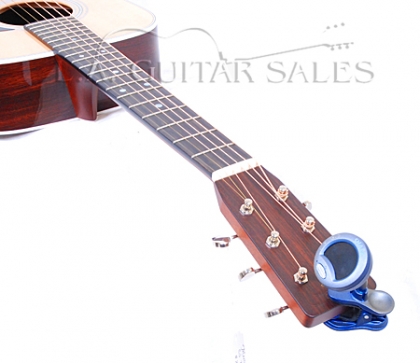We receive many inquires about acoustic guitar intonation so I thought I would list some common things that can cause poor intontaion.
High Action - Very high action/string height will cause a string to be stretched too much as it is fretted. When string height is too high, chords and notes can sound out of tune A properly set up will correc this
Excessive Neck Relief - A neck with far too much relief (bowing in the neck) not only shortens the distance between the nut and saddle, it raises the string's distance from the frets. Correct this by djusting the truss rod.
Leaning Saddle - The saddle should sit firmly in the bridge. A loose saddle can lean forward, shortening the string's length and sharpening the intonation. Correct this by replace the saddle for proper fit.
Worn Saddle Crown - Deep notches in the saddle may change the string's length. Replace or re-surface the saddle.
Fret Wear - Frets that are badly grooved or have flat crowns will also throw off intonation as the string's length is changed. Worn frets can be leveled and re-crowned to remove the grooves. Severely worn frets may require replacement.
Fret Height - Instruments with very tall fret wire can play incredibly sharp if the string is fretted hard. Using an electronic tuner fret a note and watch the tuner as you apply more or less pressure to the string to view the effects. If the fret crown is very tall, fret leveling and re-crowning can reduce it's height.
String Quality & Gauge - String quality has really only been an issue for my clients when purchasing no name strings from auction sites. While seemingly cost effective some are notorious for bad intonation. When re-stringing an instrument that has been properly set up it is important to use the same string gauge. Saddle compensation, neck relief and action have all been set for a particular string gauge. Increasing the tension of the strings can cause sharper intonation. If the instrument played in tune before and no changes have been made to the instrument you may wish to change strings first.
Saddle Placement - The string is always resting in the nut's slot and on the saddle's crown. Changing the position of the saddle or nut will therefore change the length of the string. A string that is too long will cause the intonation to be flat at the 12th fret. A string that is too short will cause the intonation to be sharp at the 12th fret. The saddle's crown may need compensation or, in more severe cases, the bridge saddle slot may need to be moved.
Fret Spacing - This is generally seen on inexpensive imported instruments and some vintage pieces with hand slotted fretboard's. To correct this would require fingerboard replacement.
Playing Technique - Some players have a rather powerful fretting technique in which they place excessive pressure on the strings when fretting. If the instrument happens to have fairly tall frets the combination often results in sharp intonation. To illustrate, use an electronic tuner and play a note using varying fretting pressure. The tuner will show you how your pressure effects the note.


